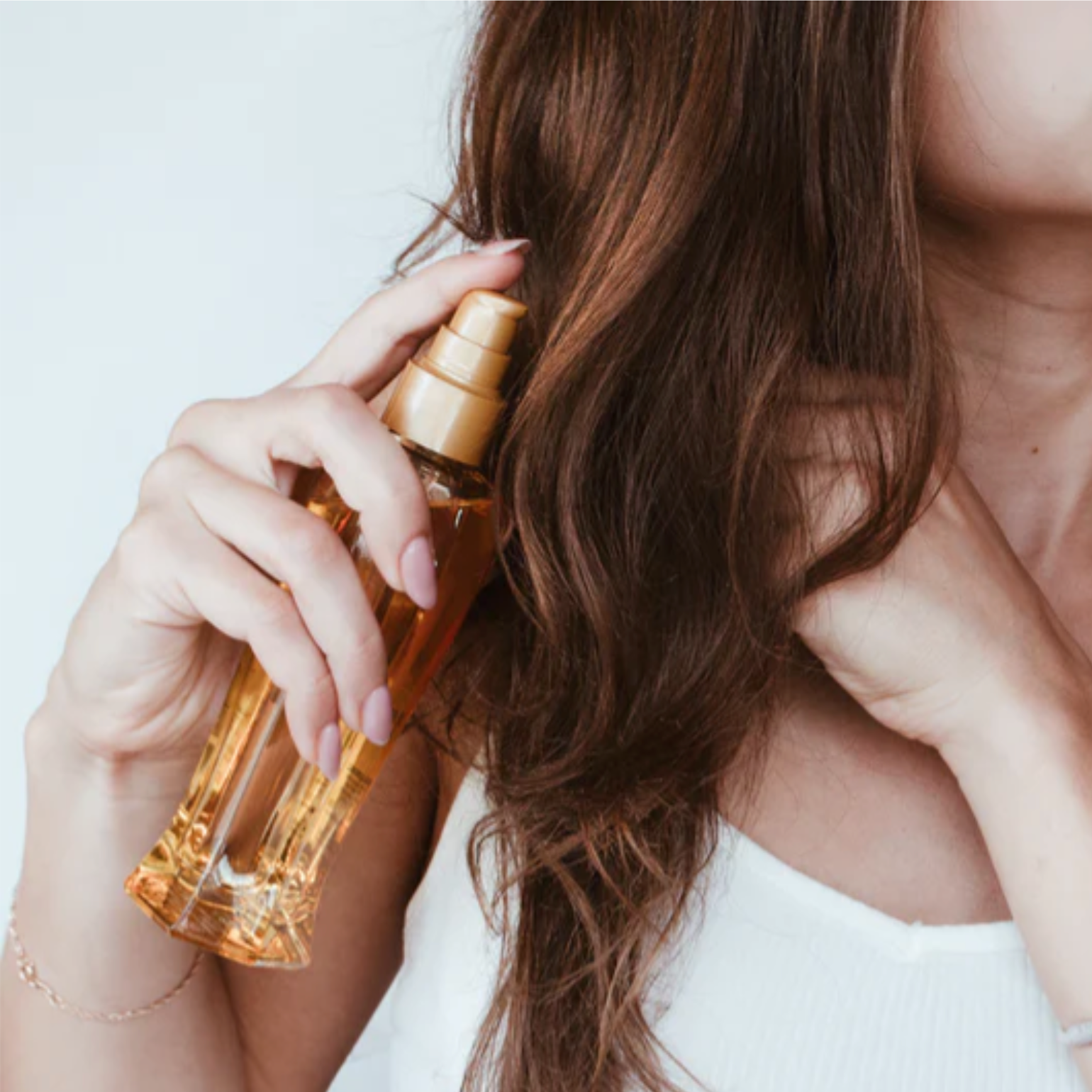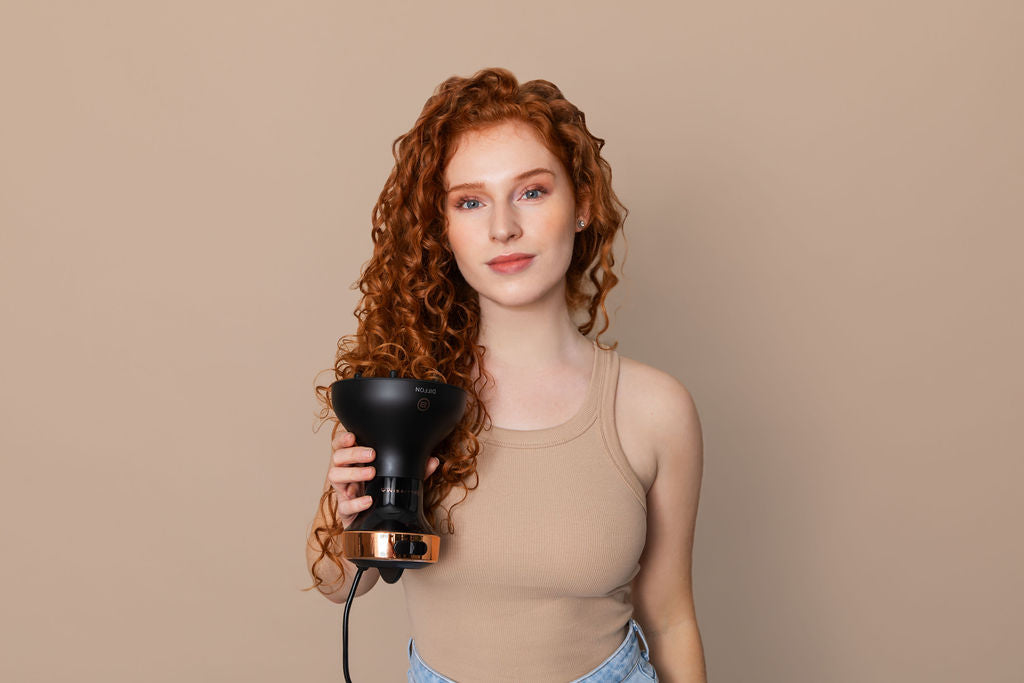Heat can damage your hair. Unfortunately, it is difficult to avoid! Whether you straighten or blow-dry it, you still might find your hair starting to become damaged from the heat.
If you’re finding your hair is looking dried out, brittle and dull, it’s time to take action. How do you repair heat-damaged hair, and - more importantly - prevent it from happening again? In this article from Bellissima Italia, we’ve got 5 easy tips to take to restore shine and health to your locks.

What Causes Heat-damaged Hair?
Your go-to styling tools are generally the culprit behind heat-damaged hair. Regular use of flat irons, curlers, or blow dryers can sap your hair's natural moisture, leaving it dry, brittle, and prone to split ends.
When you expose your hair to heat, it messes with the moisture balance. High temperatures open up the hair cuticle, causing moisture to escape. Styling tools can reach temperatures of more than 200 degrees Celsius. However, most hair types cannot handle such high heat. If you've noticed your hair has lost its shine and softness, it may have undergone heat damage.
To prevent heat damage, it’s important to use products that can promote the health of your hair. At Bellissima Italia, our products are designed to work with your hair, rather than damage it. We provide a range of styling tools, including diffusers, straighteners, hot brushes, hair dryers, and stylers.
How to Identify Heat-damaged Hair

Spotting the signs of heat damage is key to restoring your hair's health. Here's how to identify those telltale signals.
-
Texture - Run your fingers through your hair. If it feels rough, overly dry, or lacks its usual smoothness, it could be a sign of heat damage.
-
Split ends galore - Split ends are a clear indicator of damage. If you notice fraying or splitting, it's time to give your locks some attention.
-
Excessive breakage - Regular heat damage weakens your hair, leading to increased breakage. If you find more hair in your brush or on the bathroom floor than usual, it might be a sign that heat is taking a toll.
-
Lack of shine - Healthy hair has a natural shine. If your locks look dull and lacklustre, heat damage might be the culprit.
-
Brittleness - If your hair breaks easily or feels brittle, it's a sign of weakened hair structure.
- Changes in elasticity - Healthy hair is elastic and bounces back when stretched. If your hair lacks elasticity and snaps or feels rigid, it's likely damaged.
Levels of Heat-damaged Hair
Understanding the stage of heat damage is pivotal in effective care. Here are the three key levels:
1. Mild Damage:
Early signs include subtle dryness or a slight reduction in natural shine. Swift action with nourishing treatments can prevent further issues at this stage.
2. Moderate Damage:
Hair shows more noticeable problems. This could include increased dryness, split ends, and a rougher texture. Introduce intensive treatments, such as protein masks, to restore health and vitality.
3. Severe Damage:
At this critical stage, the hair cuticle is significantly compromised. This leads to excessive breakage, severe dryness, and reduced elasticity. Consider getting a professional haircut to remove damaged parts and start the rejuvenation process.
5 Tips to Repair Heat-damaged Hair

Below are the Bellissima Italia pro tips for repairing heat-damaged hair. It is worth mentioning that there are different levels of hair damage. In some severe cases, hair masks and protein restoration cannot repair the damaged hair follicles.
If you’re at this end of the spectrum, it’s best to visit your stylist. You can get a haircut to remove the most damaged parts of your hair.
1. Use a Leave-in Protein Treatment
For those dealing with mild to moderate hair damage, you can start with an intensive protein treatment. These reconstructing masks contain strengthening ingredients like hydrolysed proteins, amino acids and natural oils. They can temporarily patch up chips, cracks, and breaks in the hair cuticle. Most protein treatments work best on damp, freshly washed hair.
Leave them for five to seven minutes to allow the ingredients to get to work, and then wash out and air dry. It’s worth noting that whilst these protein-packed masks are great for breakage, split ends, and dryness, they should only be used in moderation.
The key is to balance out your protein and moisture. Stick to once or twice a month if you’re dealing with damaged hair, and don’t skip step 2. Moisturise, moisturise, moisturise.
2. Moisturise Like Your Life Depends on it (Spoiler: it Does)
It is crucial to add moisture to damaged hair to restore its shine and eliminate frizz. As soon as you start blow-drying or straightening your hair, moisture is lost. To redress this imbalance, you need to use a deep conditioner to give your hair a little love.
Look for products that feature shea butter, argan oil or coconut oil. These all contain natural oily properties that help nourish your locks. Apply your conditioner, wrap your hair in a microfibre towel or t-shirt to avoid frizz, and leave the product in your hair for the time recommended on the label. Some you can leave in overnight - others only need 20 minutes before you wash it out.
Doing this once a week with your favourite hair mask is one of the best ways to prevent long-term damage. If you’ve got curly hair, then conditioning is even more important for your hair routine. Avoid shampooing every day and only apply shampoo to the scalp and roots of your hair. This will help to keep your natural oils and combat frizz.
3. Use Heat Protectant
Don’t worry - you don’t need to ditch the styling tools for good! Adding a heat protectant is the easiest way to protect your hair before you get started with your styling routine.
A thermal protector creates a barrier between your open hair shaft and the heat. As well as detangling strands and creating less breakage when you brush through. Nourish your hair before you dry or style it by applying a protective spray to damp hair to reduce frizz and keep moisture locked in.
4. Switch up Your Styling Tools

When it is time to style your locks, then consider switching to a tool that’s more healthy for your hair. The less time your hair is exposed to heat, the less time for damage to occur.
Don't use old, worn-out straighteners that require you to go over the same pieces of hair again and again. A hot air brush is a much gentler substitute for your flat iron. It styles your hair whilst drying it, as well as having different temperature settings to avoid unnecessary heat. Our Hot Brushes are the ultimate style saviour as they have a keratin coating for added protein protection. They also take less time to style your hair! Try out different attachments to create beachy waves, bouncy curls, and straight styles! Keep your hair looking and feeling healthy without too much heat.
5. Get Regular Haircuts
When it is time to style your locks, then consider switching to a tool that’s more healthy for your hair. The less time your hair is exposed to heat, the less time for damage to occur.
Don't use old, worn-out straighteners that require you to go over the same pieces of hair again and again. A hot air brush is a much gentler substitute for your flat iron. It styles your hair whilst drying it, as well as having different temperature settings to avoid unnecessary heat. Our Hot Brushes are the ultimate style saviour as they have a keratin coating for added protein protection. They also take less time to style your hair! Try out different attachments to create beachy waves, bouncy curls, and straight styles! Keep your hair looking and feeling healthy without too much heat.
When Should You See a Professional?
It may be time to consider professional assistance if you haven't seen results in 2-3 months.
Visit a trusted salon where professionals can assess the condition of your hair. Their trained eyes can provide an accurate evaluation of the extent of the damage. From this a tailored plan for restoration and be created.
Hair professionals understand that one size does not fit all. They'll craft a custom haircutting plan designed to remove the most damaged sections. They will also preserve the length and style that suits you best.
Seeking professional guidance is not just about addressing current damage, but also preventing future issues. Experts can provide valuable tips on maintaining healthy hair, ensuring your efforts are geared towards long-term well-being!
Repairing Heat-damaged Hair: Final Thoughts
Remember that repairing heat-damaged hair is a process that takes time. Be patient and consistent with your chosen treatments. This allows your locks the opportunity to rejuvenate naturally.
Strike the right balance between protein and moisture. Regularly assess your hair's condition to tailor your care routine, ensuring it meets the specific needs of your locks. And, if at-home treatments show limited progress, don't hesitate to seek the guidance of hair professionals. Their expertise can pinpoint the best course of action! From personalised haircuts to advanced treatments.
Once you've nursed your hair back to health, focus on prevention. Limit excessive heat exposure, choose styling tools wisely, and maintain a consistent care routine to prevent future damage!
Shop Hot Brushes at Bellissima Italia

Are you looking for your next styler?
Shop our range of Hot Brushes here. At Bellissima, hair health is our key focus. Our Air Wonder 8 in 1 Hot Air Styler and the 6 in 1 Ceramic Hot Air Styler are designed to heat your hair without damaging it.
Discover our full range of hairstyling tools and keep your hair healthy.
FAQs
What is heat damaged hair?
Heat-damaged hair occurs when excessive heat from styling tools breaks down the hair’s natural proteins. This can lead to dryness, brittleness, and split ends. Overuse of flat irons, curling tools, or blow-dryers without heat protection can weaken hair structure, making it more prone to frizz and breakage.
How do you fix heat-damage without cutting your hair?
To fix heat damage without cutting your hair, prioritise deep conditioning treatments. Use protein masks, and apply heat protectants before styling. Choose gentler styling tools, such as hot air brushes, and minimise heat exposure. Regular trims can remove split ends while retaining length. Maintain a balance between protein and moisture to restore hair health.
Can hair be too damaged to fix?
In some cases, hair can reach a point where damage is irreversible. Extreme cases of breakage, severe dryness, and resistance to treatments may indicate irreparable damage. Seeking professional advice is crucial. Hairdressers can assess the extent of damage and recommend appropriate solutions. This may include a significant haircut to remove the most compromised sections.
What is the best treatment for burned hair?
The best treatment for burned hair involves a multi-faceted approach. Begin by deep conditioning with products rich in moisture and repairing ingredients like keratin. Use protein treatments to strengthen damaged strands. Limit heat exposure, with hair friendly styling tools, and apply heat protectants. Regular trims help remove burned ends. Professional consultations can guide you on tailored solutions. Prioritise a consistent, gentle care routine to gradually restore health to burned hair.


